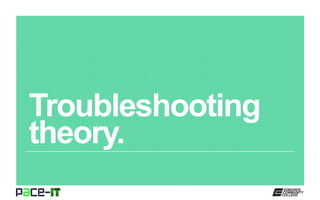
Pace IT Troubleshooting Theory
- 2. Page 2 Instructor, PACE-IT Program – Edmonds Community College Areas of Expertise Industry Certification PC Hardware Network Administration IT Project Management Network Design User Training IT Troubleshooting Qualifications Summary Education M.B.A., IT Management, Western Governor’s University B.S., IT Security, Western Governor’s University Entrepreneur, executive leader, and proven manger with 10+ years of experience turning complex issues into efficient and effective solutions. Strengths include developing and mentoring diverse workforces, improving processes, analyzing business needs and creating the solutions required— with a focus on technology.
- 3. Page 3 – The importance of having a methodology. – Six-step troubleshooting methodology. PACE-IT.
- 5. Page 5 “My methodology is not knowing what I am doing and making that work for me.” – Stone Gossard
- 6. Page 6 Due to the complexity of modern computing systems, the wise technician will follow a troubleshooting methodology. Not having a troubleshooting methodology in place can result in a bunch of wasted time and frustration, not only for the technician but also for the end user. A formal methodology gives the technician a starting place and a logical sequence of steps to follow. Troubleshooting theory.
- 8. Page 8 Troubleshooting theory. The six steps of troubleshooting. 1) Identify the problem. 2) Establish a theory of probable cause. 3) Test the theory. 4) Develop the action plan and implement the plan. 5) Verify complete system functionality. 6) Document the process.
- 9. Page 9 – Identify the problem. » Question the user. » Remember that the symptoms are not the underlying problem. » Determine what has changed. » Make a backup of the system before moving on. – Establish a theory of probable cause. » Make a list of probable causes. » Using your knowledge, prioritize the list. » Question the obvious. • Symptom: power issue at the workstation. • Obvious question: is the power cord plugged in? » Escalate to a higher level if a probable cause cannot be determined. Troubleshooting theory.
- 10. Page 10 – Test probable cause theory to determine actual cause. » Create your theory from the most likely probable cause. » If the theory is confirmed, move to the next step. » If the theory isn’t confirmed, go back to step two or step one (if needed). – Establish an action plan and execute the plan. » Simple problems probably just need simple plans. » Complex problems may need written out action plans. » Escalate to a higher level if required. Troubleshooting theory.
- 11. Page 11 – Verify full system functionality. » If everything works – great! • If applicable, implement preventative measures. » If not everything works – go back to step one. – Document the process. » Findings, actions, and outcomes. » Issues that need to be troubleshot may occur again. » Gives a history of equipment and users so that problem children become known. Troubleshooting theory.
- 12. Page 12 Troubleshooting theory. Gives a systematic approach to solving IT problems. Reduces wasted time and frustration for both the technician and the end user. Topic The importance of having a methodology. Summary Identify the problem; establish theory of probable cause; test the theory; establish a plan of action and implement it; verify system functionality; and document everything. Six-step troubleshooting methodology.
- 14. This workforce solution was 100 percent funded by a $3 million grant awarded by the U.S. Department of Labor's Employment and Training Administration. The solution was created by the grantee and does not necessarily reflect the official position of the U.S. Department of Labor. The Department of Labor makes no guarantees, warranties, or assurances of any kind, express or implied, with respect to such information, including any information on linked sites and including, but not limited to, accuracy of the information or its completeness, timeliness, usefulness, adequacy, continued availability or ownership. Funded by the Department of Labor, Employment and Training Administration, Grant #TC-23745-12-60-A-53. PACE-IT is an equal opportunity employer/program and auxiliary aids and services are available upon request to individuals with disabilities. For those that are hearing impaired, a video phone is available at the Services for Students with Disabilities (SSD) office in Mountlake Terrace Hall 159. Check www.edcc.edu/ssd for office hours. Call 425.354.3113 on a video phone for more information about the PACE-IT program. For any additional special accommodations needed, call the SSD office at 425.640.1814. Edmonds Community College does not discriminate on the basis of race; color; religion; national origin; sex; disability; sexual orientation; age; citizenship, marital, or veteran status; or genetic information in its programs and activities.
